In the past two decades, innovators have come up with different ways to connect service providers to people who need what they have to offer.
The solution they came up with is known as a two-sided marketplace.
These marketplaces have gained popularity in recent years as they provide a convenient and efficient solution for customers and sellers to interact and transact.
But what two-sided marketplaces are? And what set them apart from other online marketplaces?
In this article, we’ll explore the benefits of two-sided marketplaces, the challenges business owners face, and what are the steps to build your own platform.
Table of contents
What is a two-sided marketplace?
A two-sided marketplace is a trustworthy intermediary or platform that brings buyers and sellers together to create value and fulfill each other’s needs.
Unlike one-sided marketplaces where one seller interacts with many buyers, two-sided marketplaces operate under a business model that connects people that need products or services with people that offer them.
For example, an online tutoring marketplace platform where tutors offer their services to students or a coaching marketplace where different coaches offer free or paid sessions.
Advantages of two-sided marketplaces
Two-sided marketplaces are popular because they are beneficial to both sellers and buyers.
Let’s have a look at some advantages of owning a two-sided marketplace.
Buyers can find products and services easily
Two-sided marketplaces make it easier, cheaper, and faster for buyers to find sellers that have what they need.
For example, think about how people got taxis before Uber started.
Most times, people had to stand on the street and wait for a taxi to speed by. Then they’d stop the taxi and get in without knowing anything about the driver or how much they’d have to pay for their destination.
When Uber entered the market, that all changed.
With Uber, people are able to book a ride in advance, get information about their driver and the car they’ll be using, and how much they’ll pay to get to their destination.
Buyers get quality services
Many new businesses use the two-sided marketplace business model. Because of this, they face a tremendous amount of competition.
This causes them to prioritize high-quality services as that’s the only way they’d have a competitive edge in the market.
Take Airbnb as an example.
If you have an apartment you want to use as an Airbnb, the first thing you’d have to do is clean up the place and make it look attractive to potential renters.
That’s the selling point for Airbnb — giving their customers access to beautiful spaces that feel like home, as opposed to a generic hotel room.
Marketplace brands are scalable at little cost
The purpose of a two-sided marketplace is to bring service providers and customers together to exchange value.
The marketplace itself does not have to own much.
For example, Uber doesn’t own any cars. It just connects car owners with passengers. The same goes for Airbnb. Airbnb doesn’t own any houses or living spaces. It just connects people who have these spaces to people who need them.
So when a two-sided marketplace is set up, both sides (service providers and customers) can scale infinitely.
It’ll cost very little — or even nothing — to add another service provider or customer to the network of users.
With time, the marketplace becomes a self-sustaining and value-providing business that people trust.
💡 Pro tip
Choose a scalable marketplace platform. 3veta is a white-label marketplace solution that allows your users to list their services, schedule meetings, get booked, accept payments, and host video calls without sacrificing your branding.
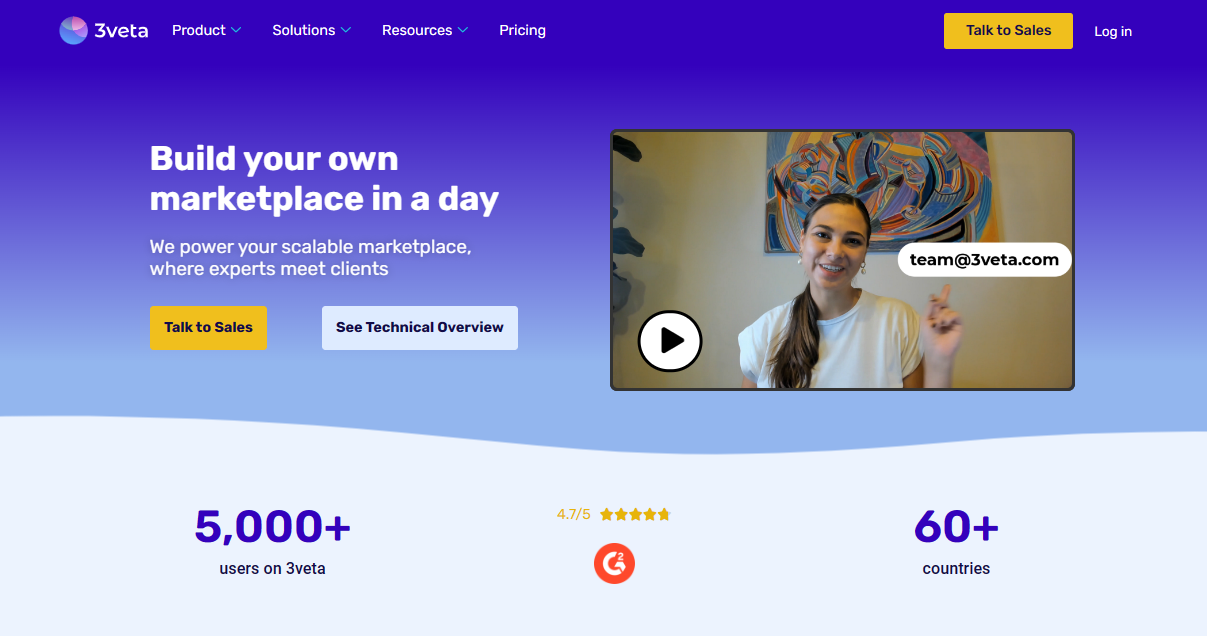
Challenges of two-sided marketplaces
While two-sided marketplaces are valuable to both vendors and consumers, they face some challenges that can stunt their growth and performance.
Below we’ll explore some of these challenges.
The chicken-and-egg problem
What comes first: the chicken or the egg?
It’s an age-old question, and people have different answers and logic to explain those answers. Yet, the question is never solved.
The same dilemma faces two-sided marketplaces.
Since these platforms cater to both sellers and buyers, which set of users should the marketplace target first?
Buyers aren’t likely to use a marketplace if it doesn’t offer enough products. And sellers won’t be motivated to sign up to the marketplace until they’re sure that there is an existing demand for their services or products on the platform.
Most times, the solution is to focus on the side that is more difficult to get in the marketplace niche.
For example, in its early days, Uber targeted drivers first because it was easier to find people who needed taxis than it was to find reliable people who owned cars.
So if you want to start a marketplace that offers accounting services to businesses, you’ll need to focus on finding accountant companies first.
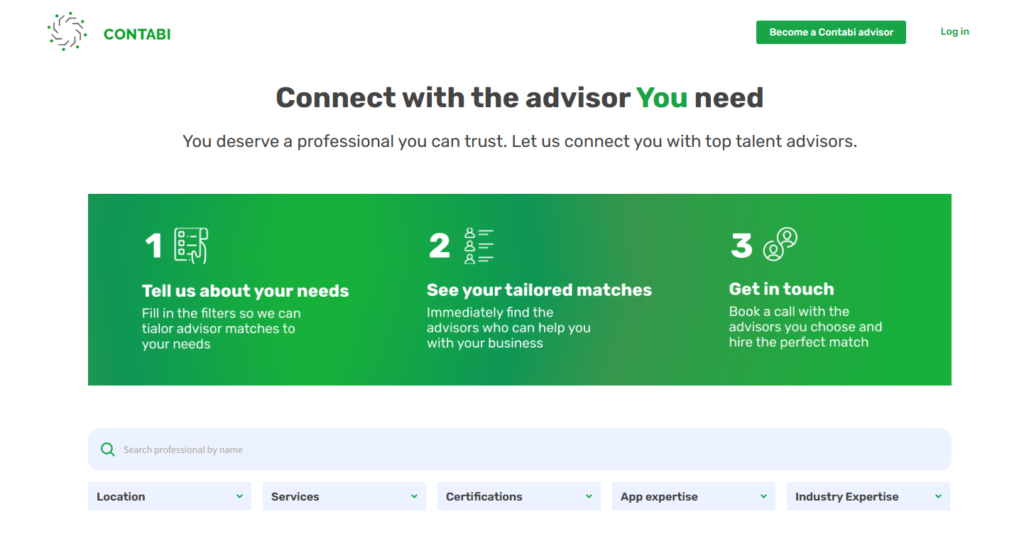
Contabi uses 3veta’s marketplace builder to connect advisors with businesses that need such services.
Once you get the side that is harder to get, the easier side is attracted almost immediately.
Building trust
Two-sided marketplace owners need to focus on building trust with users. Both service providers and clients need to trust each other and the platform before they invest their money, or even their safety in the business.
One of the reasons people trust Uber is because they know that Uber vets all its riders and their vehicles before accepting them onto the platform.
Two-sided marketplaces only thrive when they ensure that the service providers they let on are offering high-quality products. However, vetting sellers and their services or products can be difficult, especially when the marketplace is mature (i.e. has a lot of sellers and buyers already).
Marketplace platform leakage
Two-sided marketplaces often control the entire transaction flow between service providers and customers — often taking their cut from the buyer’s payment.
This system ensures that both parties experience a smooth transaction process and that a customer support agent can step in if something goes wrong with payments.
However, if the payment flow isn’t frictionless, a service provider might try to arrange payment outside the marketplace to avoid paying a commission (depending on the service marketplace business model). This is marketplace platform leakage.
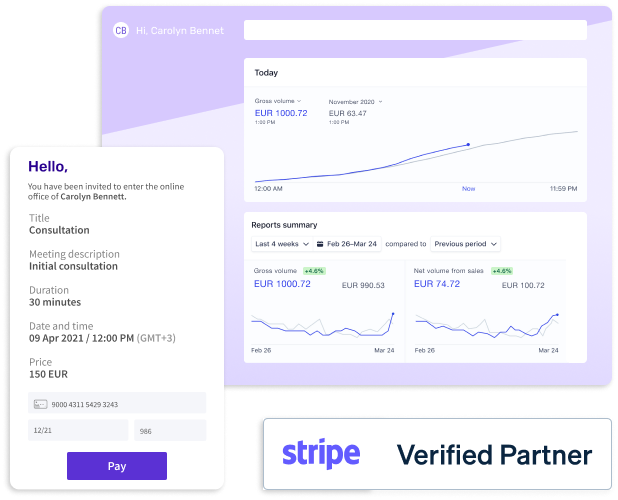
3veta offers a secure payment integration with Stripe to arrange payments between service providers and customers without leaving your marketplace. Furthermore, it allows you to decide if you want to charge a percentage of each transaction and how much it should be.
Apart from costing the marketplace its profits, platform leakage exposes users to fraud and makes it harder to build trust.
How to start a two-sided service marketplace?
If you want to build a two-sided marketplace, here are five steps you should take:
Pick a niche
First, you’ll need to decide the niche in which you want to create a two-sided service marketplace.
Ideally, your niche should be one you’re an expert at, as that would mean that you understand the needs of buyers and service providers in that niche.
If you’re picking a niche you don’t have expertise in, you should do as much research as possible into it. If that idea doesn’t have a two-sided marketplace yet, you can step in and fill that gap right away.
Note
The narrower your niche, the easier it’ll be to build trust and attract both buyers and sellers.
Identify the value exchange
Next, you need to figure out the exact kind of transactions buyers and sellers must complete to exchange value.
For example, in Airbnb, the transaction happens when homeowners put their homes up for rent for a period of time and vacationers (or tourists) pay for available spaces.
As you work out what services people would offer on your marketplace, make sure you research the needs of the supply and demand sides before you start developing your marketplace platform.
Build an MVP
A Minimum Viable Product, or MVP, is an early version of a product that has all the necessary functionality so you can get the benefits of a business model while reducing the inherent challenges.
For a marketplace, this functionality includes all the necessary service marketplace features: a profile and listing creation, complete admin tools, frictionless transaction flow, communication features, etc.
The primary purpose of MVPs is to validate a product idea early in the product development process.
Creating an MVP can help your product team gather customer feedback quickly so they can improve the marketplace.

3veta helps you prototype and test your marketplace idea without the need for any developers. We’ve got all the modules you need to build a fully-functional service marketplace.
Building and launching your MVP shouldn’t take up too much time or resources.
Instead of spending time and money making your MVP look perfect, channel those assets into user research, marketing, and community-building.
Focus on finding service providers
The chicken-or-egg problem is a downside of the network effect caused by two-sided marketplaces.
As mentioned earlier, focus your marketing efforts on the side that is more difficult to get. Most times, the harder side is the sellers.
If buyers can’t find the products they’re looking for on your marketplace, they’ll churn. So get sellers first. Once people list products or services on your marketplace, it’ll be easier to get customers to buy.
Reach liquidity
After fixing the chicken-or-egg problem, focus on making your marketplace liquid by meeting the expectations of both sellers and buyers.
In a liquid marketplace, customers are able to find what they’re looking for on your platform and sellers are able to sell their services to these buyers. Buyers get enough product variety; sellers get enough buyers.
An example of a liquid marketplace is eBay. On eBay, there’s a high probability that a seller listing a product or service on the platform will find people that are interested in their offer, no matter the location.
The best way to reach liquidity is to pick a small niche and expand slowly.
For instance, a health and wellness marketplace might be tempted to offer all kinds of fitness coaching, nutrition, and yoga session services. The downside of this is that the platform will need many buyers and sellers to ensure that a user can find the exact client or service they’re looking for.
However, if a health and wellness marketplace focuses on personal training services, it’ll be easier to solve the liquidity problem. Once that’s done, the marketplace can expand gradually to include other types of food.
Examples of two-sided marketplaces
Throughout this piece, we’ve seen how popular businesses like Uber, Airbnb, and eBay qualify as two-sided marketplaces. Let’s look at three other examples of two-sided marketplaces and how they work:
Etsy
Etsy is a two-sided marketplace that focuses on exchanging handmade and vintage items, including jewelry, clothing, and home décor.
On Etsy, sellers can set up a virtual store to display their crafts — with the prices and steps to order. Buyers then look through the offers and place orders on items they want to purchase.
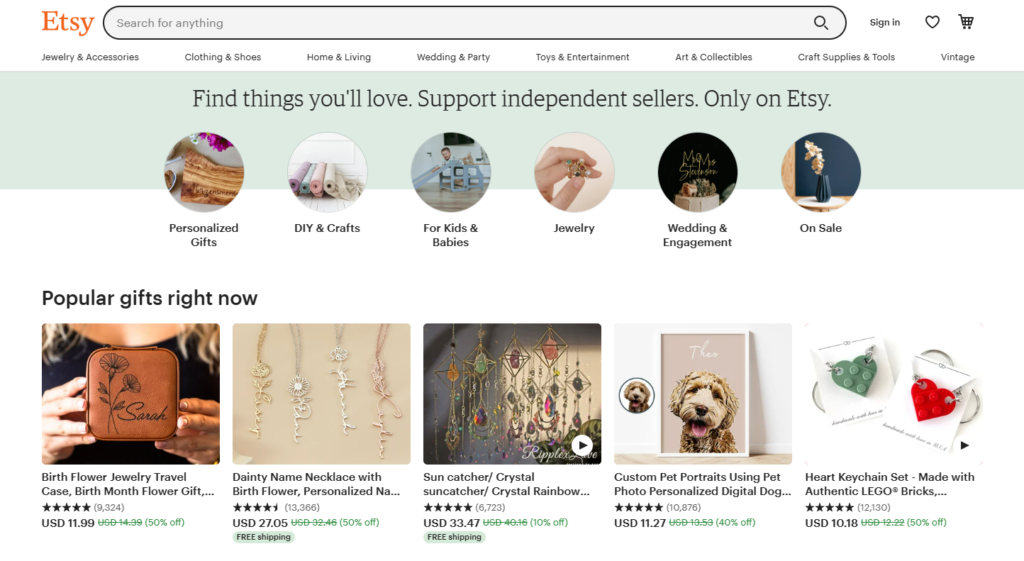
While Etsy brings craftspeople and buyers together, it also offers lectures and workshops for people who are interested in crafts and/or want to sell on the platform.
Etsy also has a way of turning sellers into buyers, and vice versa. They take advantage of the fact that most craftspeople — including those selling their products online — like to buy from other craftspeople as a way of supporting them. They also appeal to buyers who also make crafts and encourage them to sell through Etsy.
Rover
The purpose of Rover is to connect dog owners with a network of dog lovers for hire who offer services like dog walking, dog sitting, and dog boarding. These dog walkers are spread out across the United States.
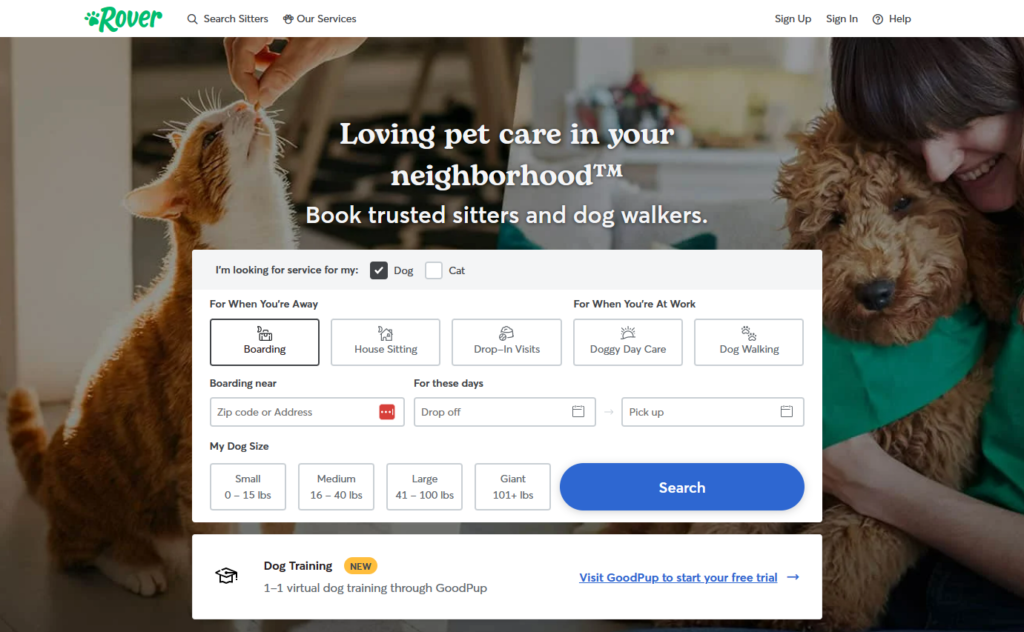
Pet owners can sign up to the platform for free, while the service providers pay $10-$35 for a background check.
When a pet owner hires a service provider, Rover takes about 20% of the fee and gives the provider 80%. Pet owners, on the other hand, have to pay a service fee of up to 7% in addition to the provider’s rate.
Upwork
Upwork is a freelancing marketplace that involves two parties: employers and freelancers.
The way it works is simple: employers in need of freelancers post their job offers and specifications for free on the platform.
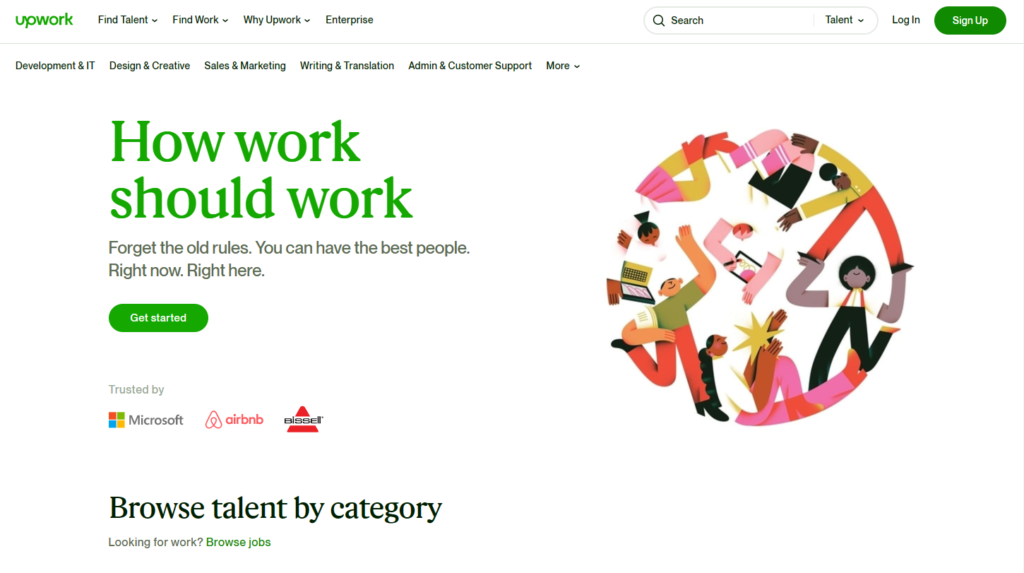
Freelance candidates who are interested in a job offer can make bids, and send their resumes, cover letters, and samples to the employer. The employer will look through the applications and hire the person they feel is most qualified for the role.
It’s a great place for both contractors and employers to network and expand their connections.
When the employer is set to pay the freelancer, Upwork takes between 10-20% of the fee for itself.
Build a profitable two-sided marketplace with 3veta
3veta helps you manage resources and provide quality end-to-end service for both sides of your marketplace.
With 3veta’s marketplace builder, you get a branded marketplace that is tailored to your business needs: service listings, booking pages, in-app video calls, scheduling, secure payments, and more.
Let’s get in touch and we’ll show you how 3veta can be applied to your use case.

Althea Storm
Althea Storm is a B2B SaaS writer who specializes in creating data-driven content that drives traffic and increases conversions for businesses — small startups and large businesses alike. She has worked with top companies like AdEspresso, HubSpot, Thinkific, and Zapier.



